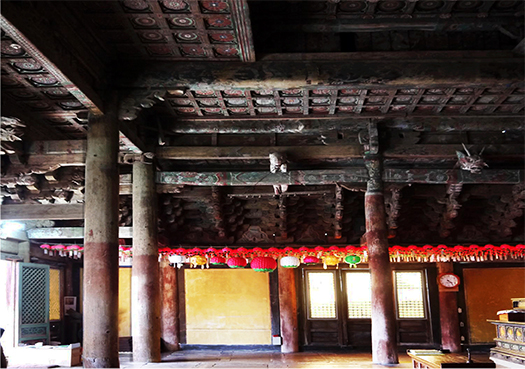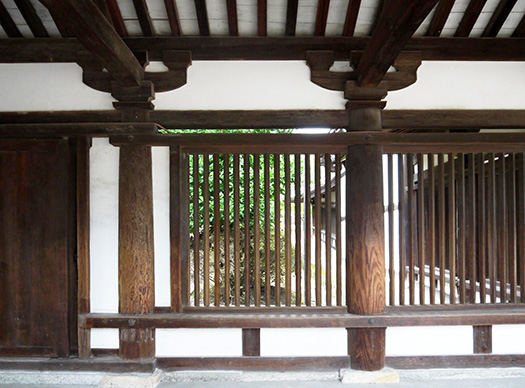

東アジアの建築の比較検討って興味深い。
先般の韓国訪問・安東河回村探訪記シリーズでかなり日韓・日朝の
相似性と相違性をいろいろに考えさせられた次第。
その余韻からまだ抜けきっておりません(笑)。
で、木造建築ということを考えて行くと当然、宗教建築も興味を持つ。
そこで韓国でも最古級の寺院建築「仏国寺」を見た。
いろいろな異国情緒を味わってきたのですが、
木材加工への意識の違いが色濃く感じられてならない。
上の写真は仏国寺の「大雄殿」の内観写真です。
韓国の木造建築を見続けてきて、建築素材の「加工」において
自然の樹相そのままの微妙なねじれやソリをそのままにして
樹皮を剥いだそのままに使うという傾向を強く感じる。
もう少し細い構造材でも丸太まんまという使用状況がわかる。
一方下の写真は法隆寺の回廊部分の木組みの写真。
柱には「エンタシス」と呼べる中太りの加工が施されている様子がわかる。
創建年代は法隆寺と仏国寺では150年ほど違いがあって
法隆寺創建は607年とより古いけれど、ディテール完成度がむしろ高いように感じる。
むろん仏国寺は文禄の役の秀吉の朝鮮出兵時の戦争で焼失し
建築はその後の再建であるという事情はあるけれど、
それはむしろより進化した木造技術が付与される方向に働く機縁だと思うけれど、
かえってより始原的な印象が強く感じられる。
このことはどういうことをあらわしているのだろうか。
現地見学時にはそこまで気付きを得ることはできなかったのですが、
そのときの体感印象をベースにして写真データを参照してると
こういった気付きが強くなってきた次第なのです。
現代では韓国の木造軸組建築伝統・韓屋は廃れる一方だったとされるのですが、
この分野でも日韓の微妙な関係からか、交流は不活発のようです。
むしろ中国とは日本の国交省関連団体がほぼ消滅していた木造技術の
復元に技術面で支援を行ってきていたり、
台湾とは民間団体レベルでも現地に残る日本統治時代の在来木造建築を
保守したりあらたに新築住宅として建築が活発化するなどしている。
韓国の木造の状況の研究領域でも日本には断片的に論文もあるけれど、
韓国側での研究成果を確認することはできていません。
想像としては日本よりも森林の生育復元環境では不利な条件下で
薪バイオマスを大量使用するオンドル暖房が森林荒廃を呼び
木材加工技術が社会から失われていった可能性が浮かんでくるように思う。
日本の場合には旺盛な木造建築需要に支えられて
木材の加工技術・木挽き技術が発達して行った様子がわかる。
現場での施工性・作業効率性がより高いと思われる「角材」もしくは
この法隆寺エンタシスのような加工を施した建材を使うようになった。
韓国・朝鮮ではそれなりの味わいの深い、素材そのままではあるけれど、
不揃いの生成り建材は現場で納めるには非常に困難だっただろうと推測できる。
まぁだからそれほど木造技術が発展しなかったとも考えられるのだろうか。
写真を見比べてみて、両国の先人たちの状況を想像させられる次第。
English version⬇
[Wood processing technology of Horyuji Temple and Bulguksa Temple, South Korea]
It is interesting to compare East Asian architecture.
In the recent visit to South Korea and the Andong Hahoe Village Exploration Series, it was quite Japan-Korea and Japan-North Korea.
As soon as I was made to think about similarities and differences.
I haven’t come out of that lingering sound yet (laughs).
So, of course, when I think about wooden architecture, I’m also interested in religious architecture.
There, I saw the oldest temple building in Korea, “Bulguksa Temple”.
I have experienced various exoticisms,
The difference in consciousness about wood processing should not be felt strongly.
The photo above is an inside photo of the “Daioden” at Bulguksa Temple.
Continuing to look at Korean wooden architecture, in the “processing” of building materials
Leave the subtle twists and warps of the natural foliage as it is
I strongly feel the tendency to use the bark as it is.
You can see the usage situation of log manma even with a slightly thinner structural material.
On the other hand, the photo below is a photo of the half-timbered part of the corridor of Horyuji Temple.
You can see that the pillars are processed to be medium-thick, which can be called “entasis”.
There is a difference of about 150 years between Horyuji Temple and Bulguksa Temple.
Horyuji Temple was built in 607, but I feel that the details are rather complete.
Of course, Bulguksa Temple was burnt down in the war when Hideyoshi, who played the role of Bunroku, was dispatched to Korea.
Although there are circumstances in which the architecture is a subsequent reconstruction,
I think it is a mechanism that works in the direction of giving more advanced wooden technology,
On the contrary, it gives a stronger impression of primitiveness.
What does this mean?
I didn’t notice that much when I visited the site,
If you refer to the photo data based on the impression you experienced at that time
This kind of awareness has become stronger.
It is said that the traditional Korean wooden frame architecture, Hanok, has been obsolete in modern times.
Even in this field, exchanges seem to be inactive, probably because of the delicate relationship between Japan and South Korea.
Rather, in China, Japanese Ministry of Land, Infrastructure, Transport and Tourism-related organizations have almost disappeared.
We have provided technical support for restoration,
With Taiwan, the traditional wooden architecture of the Japanese colonial era that remains in the field even at the level of private organizations
It is being maintained and new construction is becoming more active as a new house.
Even in the area of research on the situation of wooden structures in South Korea, there are fragmentary papers in Japan,
We have not been able to confirm the research results on the Korean side.
Imagine that under conditions that are more unfavorable in a forest growth restoration environment than in Japan.
Ondol heating, which uses a large amount of firewood biomass, calls for forest devastation
I think it is possible that wood processing technology has been lost from society.
In the case of Japan, supported by strong demand for wooden buildings
You can see how the wood processing technology and wood grinding technology have developed.
Square lumber that seems to have higher workability and work efficiency on site
I came to use building materials that had been processed like this Horyuji entasis.
In South Korea, the ingredients have a deep taste, but the ingredients are the same.
It can be inferred that uneven building materials would have been extremely difficult to deliver to the site.
Well, is it possible that the wooden technology did not develop so much?
As soon as you can compare the photos and imagine the situation of the ancestors.
Posted on 9月 13th, 2021 by 三木 奎吾
Filed under: 住宅マーケティング, 日本社会・文化研究







コメントを投稿
「※誹謗中傷や、悪意のある書き込み、営利目的などのコメントを防ぐために、投稿された全てのコメントは一時的に保留されますのでご了承ください。」
You must be logged in to post a comment.